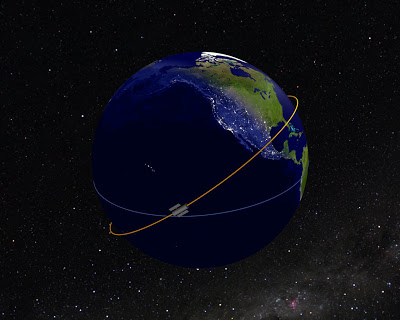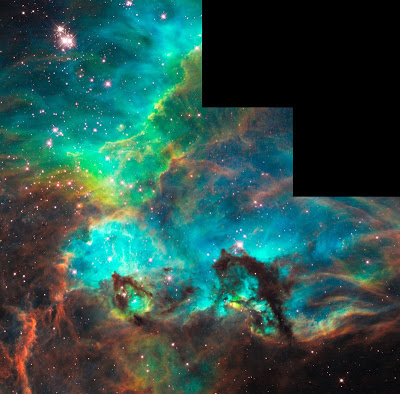Hubble's 100,000th Orbit

The Hubble Space Telescope has just recently completed its 100,000th orbit around Earth today, August 11, 2008. The telescope reached that milestone above the Pacific Ocean (Illustration above). It has been a long journey for this famous telescope, 18 years long, one that has let humans learn so much about the universe. However, it has not always been an easy life for the Hubble, marked by quite a few challenges and repairs. To mark this special event, the researchers at the Space Telescope Institute in Baltimore, Maryland have decided to do something special.
These researchers decided to point the giant space telescope at a part of the nebula near star cluster NGC 2074. The nebula, 170,000 light-years away from us, is an intense area of star formation that may have been caused by a supernova explosion nearby. It is located in the Large Magellanic Cloud, which is a satellite of the Milky Way galaxy.
The colorful image taken by the Hubble, below, reveals many features of the nebula lighted up by strong ultraviolet radiation. Young stars existing in NGC 2074 are emitting strong radiation that is eating away the edges of the nebula. The area covered by the image spans a massive 100 light-years and huge towers of dust come out of the bright colorful walls of gas that form part of a large molecular cloud. To give a sense of scale, the seahorse-shaped tower at lower, right in the image measures about 20 light-years in length, approximately 4 times the distance between the Sun and Alpha Centauri, the nearest star to our sun!

This color image was taken by the Wide Field Planetary Camera 2 onboard the Hubble Space Telescope on August 10, 2008. The Red colors show emission from sulfur atoms, green from glowing hydrogen, and blue from glowing oxygen.
Images: NASA
- Images Released By Hubble Telescope After Repair
Hubble telescope has finally got repaired and NASA scientists have released the first images taken by the telescope after repair. The image is of planetary nebula NGC 6302. I have defined planetary nebula in my earlier posts also. The image is simply...
- Picture Of Cat's Eye Nebula
The Cat's eye nebula is a planetary nebula in the constellation of Draco. A nebula is a cloud of dust and gas in space. A nebula is of four types- planetary nebula , reflection nebula , emission nebula and absorption nebula. Cat's nebula can...
- Fireworks In Helix Nebula
Image taken by Subaru Telescope shows comet -shaped knots lighting up the Helix nebula. A nebula is cloud of gas and dust in space. Some nebulas are regions where new stars are being formed, while others are the remains of dead or dying stars. Nebulas...
- Hubble's 17th Birthday!
Today is the 17th anniversary of the launch and deployment of the Hubble Space Telescope. To celebrate, the Hubble Space Telescope has taken one of the largest panoramas it has ever taken, called "The Carina Nebula: Star Birth in the Extreme", (shown...
- How Cosmic Wind Impacts Galaxies Evolution Revealed
Astronomers now know how cosmic winds strongly impacts galaxies, sweeping out interstellar material and stopping future star formation. According to astronomer Jeffrey Kenney, the cosmic wind erodes the gas and dust at the leading edge of the galaxy....
